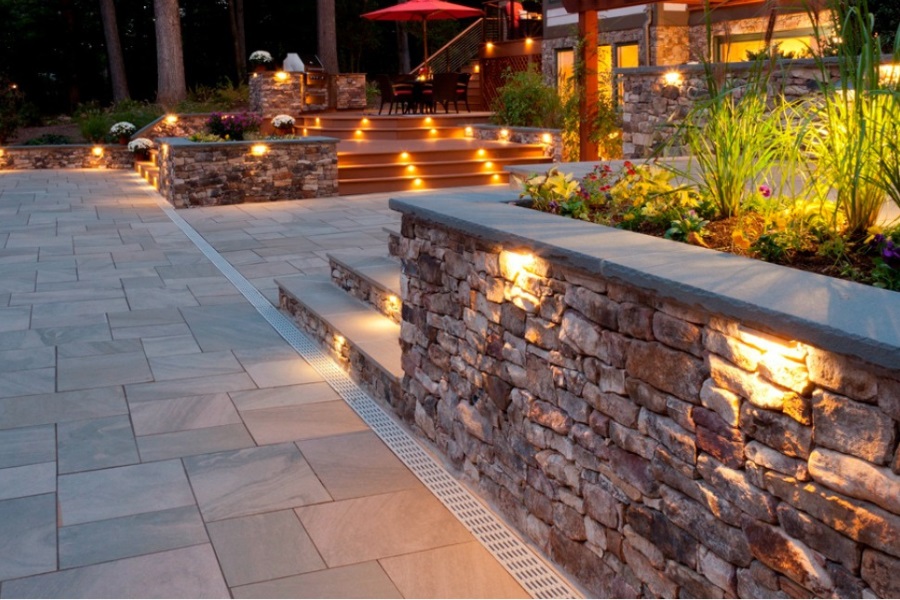Stone retaining walls are more than just functional structures that hold soil in place; they’re also beautiful design elements that can transform the entire look of your outdoor space. Many homeowners stop at the construction stage, forgetting that retaining walls have incredible potential to blend with landscaping and lighting. When thoughtfully integrated, these walls can add elegance, charm, and value to your property.
But how do you take a simple stone retaining wall and elevate it into a centerpiece of your yard? Let’s discuss how landscaping and lighting can bring your wall to life, making it both practical and visually stunning.
Why Integration Matters
A stone retaining wall on its own already carries rustic beauty and durability. However, if left bare, it might look plain or out of place compared to the rest of your landscaping. By blending plants, flowers, shrubs, and carefully placed lights, you create a cohesive environment where the wall becomes a natural part of your outdoor design.
Ask yourself this: do you want your retaining wall to fade into the background, or would you like it to stand out as a showpiece? Integration gives you the freedom to choose how the wall works with your space.
Landscaping Around Stone Retaining Walls
Landscaping is often the first step in making your stone wall look more inviting. By incorporating principles of modern landscape design, the textures of natural stone complement greenery beautifully, creating a contrast that feels organic and balanced. Here are some ideas to inspire your design:
1. Layered Planting
Planting in layers along the top and base of the wall adds depth. Use taller plants or ornamental grasses behind the wall, medium-sized shrubs along the top edge, and colorful ground covers or flowers at the bottom. This approach makes your wall blend seamlessly into the landscape, rather than standing out as a standalone structure.
2. Cascading Plants
Creeping plants like ivy, creeping thyme, or vinca minor can spill over the edge of the wall, softening the harsh lines of stone. This gives the appearance of nature and architecture merging together. Doesn’t the idea of a stone wall draped with cascading greenery sound charming?
3. Seasonal Color
You don’t have to stick with evergreen plants alone. Incorporating seasonal flowers—like tulips in spring, marigolds in summer, and mums in autumn—keeps your retaining wall visually fresh throughout the year.
4. Edible Gardens
For those who love practicality, why not turn the space around your wall into a mini edible garden? Herbs like rosemary, thyme, or basil thrive near stone walls, and they release a wonderful fragrance as you walk by.
Lighting for Stone Retaining Walls
Lighting has the power to completely transform how your retaining wall looks after sunset. A well-lit wall not only adds beauty but also increases safety by illuminating pathways and steps.
1. Uplighting
Installing lights at the base of the wall that shine upward highlights the textures of the stone. This creates dramatic shadows and turns your wall into a nighttime focal point.
2. Downlighting
Lights mounted above or within the wall that shine downward offer a softer, more natural look. It resembles moonlight and can make your outdoor space feel warm and inviting.
3. Step or Pathway Lighting
If your wall is part of a terrace or includes built-in steps, adding small lights along the path ensures safety while creating a beautiful layered glow.
4. Integrated LED Strips
For a modern touch, consider hidden LED strips built into the wall itself. These provide sleek, even illumination that enhances both form and function.
Have you ever noticed how a simple structure takes on an entirely new character with the right lighting? Stone walls are no exception.
Blending Landscaping and Lighting Together
The true magic happens when landscaping and lighting are combined. Imagine a cascading vine spilling over your stone wall, softly illuminated by warm uplights. Or consider a layered planting bed glowing gently under subtle downlighting.
The interplay between greenery, flowers, and illumination creates a sense of depth, movement, and life. It’s not just about aesthetics—it’s about crafting an atmosphere.
Practical Benefits Beyond Beauty
You may wonder: is all this effort worth it? Beyond appearances, there are practical advantages to integrating landscaping and lighting with your retaining walls.
- Erosion Control: Plants help stabilize the soil around your wall, reducing the risk of erosion.
- Safety: Lighting prevents accidents, especially near steps or uneven ground.
- Extended Usability: A well-lit wall makes your yard usable at night for gatherings, relaxation, or outdoor dining.
- Increased Property Value: Buyers often see thoughtfully designed landscaping and lighting as a sign of a well-maintained home.
Choosing the Right Plants for Your Wall
Not every plant thrives around stone retaining walls. Let’s discuss a few good options:
- Creeping Jenny: Perfect for cascading over edges with its vibrant green leaves.
- Sedum: A drought-tolerant plant that adds texture.
- Lavender: Adds color, fragrance, and attracts pollinators.
- Hostas: Great for shaded areas near walls.
- Boxwood shrubs: Perfect for creating structure and elegance.
When choosing plants, think about your wall’s exposure. Is it mostly sunny, shady, or mixed? The right choice ensures your plants thrive with minimal effort.
Tips for Lighting Placement
Lighting placement is as important as the fixtures you choose. Here are some tips to get it right:
- Place uplights at varied angles to highlight the wall’s texture.
- Avoid harsh, direct lighting that creates glare.
- Use warm-toned LEDs to mimic natural sunlight.
- Balance light across the wall instead of concentrating it in one spot.
Remember, the goal is subtle beauty, not stadium lighting.
DIY vs. Professional Installation
This leads to an important question: should you attempt to integrate landscaping and lighting around your stone retaining wall yourself, or hire a professional?
- DIY Approach: Perfect for small walls and basic lighting. It’s budget-friendly and gives you creative freedom.
- Professional Approach: Recommended for larger walls, complex designs, or when electrical work is involved. Experts can ensure proper drainage, wiring safety, and plant placement for long-term success.
Sometimes, a mix of both works best. You can plant greenery yourself while leaving lighting installation to a professional.
Common Mistakes to Avoid
To help you make the most of your retaining wall design, here are some pitfalls to avoid:
- Overcrowding Plants: Too many plants can cause root competition and overwhelm the space.
- Poor Drainage Planning: Ignoring drainage can damage both plants and the wall.
- Harsh Lighting: Bright lights can look unnatural and ruin the ambiance.
- Ignoring Maintenance: Landscaping and lighting both require upkeep to stay effective.
The Bigger Picture: Creating Outdoor Harmony
At the heart of it, integrating landscaping and lighting with your stone retaining wall is about harmony. You’re combining natural elements with human-made structures and enhancing them with light. The result is an outdoor space that feels balanced, welcoming, and timeless.
So ask yourself: what do you want your wall to say about your property? Should it whisper elegance through cascading flowers and soft lighting, or stand boldly as a dramatic centerpiece?
Final Thoughts
Stone retaining walls are already strong, durable, and beautiful on their own. But when you take the extra step to integrate landscaping and lighting, they transform into something extraordinary. These walls become part of your home’s story—a blend of structure and style that welcomes you every time you step outside.
Whether you go for subtle vines with soft downlighting or bold layers of plants with dramatic uplights, the combination will enhance not only your wall but your entire outdoor living experience.
So, next time you look at your stone retaining wall, don’t just see it as a boundary. See it as an opportunity to create beauty, safety, and value for years to come.

